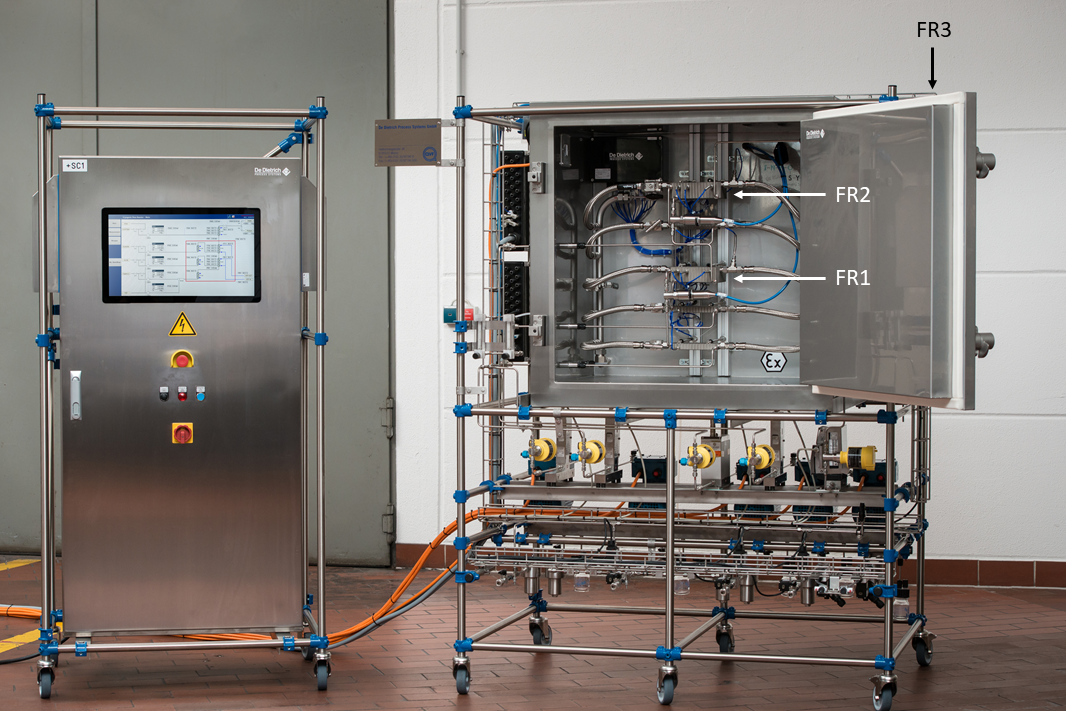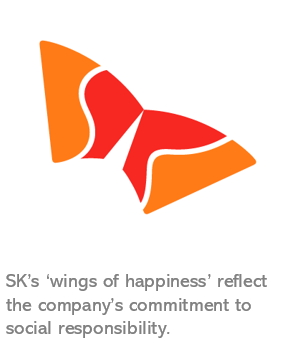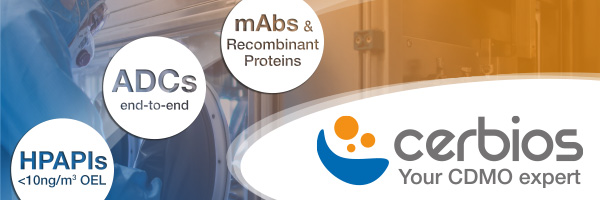Contract Services
Breaking technologies in pharma manufacturing 11th November 2019
By Editorial Team
As pharma shows robust global growth of 2.48%, the strength of the industry is reflected in its continued innovation and breaking
As pharma shows robust global growth of 2.48%, the strength of the industry is reflected in its continued innovation and breaking technologies that enhance manufacturing efficiencies and broaden the scope for potential therapeutic targets. Sarah Harding, PhD, reports from CPhI Worldwide.
CPhI Worldwide – the world’s largest pharma event – saw 45,000 visitors gather in Frankfurt, Germany, on 5–7 November 2019. Visitors came from over 160 countries for unbeatable insights into pharma’s latest trends and developments. Simultaneous with the event, CPhI launched this year’s Annual Report, including an evaluation of the pharma industry that suggested global growth of 2.48% in 2019. This healthy growth was interpreted as indicating increased confidence in the global marketplace, supported by broad innovation, breaking technologies and digitalization of the industry.
Demand for enhanced productivity, cost efficiency and sustainability are driving many of the disruptive technologies in pharma manufacturing. This is especially pertinent in light of the emerging model of personalized medicine, which is creating significant changes in the market, advised Peter Solkner, Managing Director of Vetter Pharma International. As many new drugs are developed for targeted population cohorts, the market sizes for those drugs are likely to shrink. As a result, explained Stuart Needleman, Chief Commercial Officer at Piramal Pharma Solutions, patient centricity is increasingly a focus of the pharma industry.
“There is still a lot of room for big volume products,” commented Dago Caceres, Global Marketing Leader at DuPont. “But the market for personalized medicine is growing – often for orphan indications, for which there are about 7,000 products in the pipeline worldwide. For these more focussed therapies, we need to make sure we maintain efficiencies while addressing smaller volumes.”
There can be no doubt that new models of healthcare, and the shift towards smaller volume therapies for targeted cohorts, are likely to have profound effects on the pharma supply chain. The future is likely to require more flexible manufacturing that must be as efficient as possible, as solutions for enhancing production help the industry to maintain its growth and ensure affordable, accessible healthcare for patients across the world.
Formulating solutions
A common solution is the implementation of ‘green chemistry’. Although the term was popularized in the 1990s due to an emerging awareness of chemical pollution and resource depletion, the basic principles of green chemistry – ensuring that chemical manufacturing is as efficient and economical as possible – have always been the basis of good chemical production. In other words, employing a green chemistry approach could add not just to a company’s sustainability credentials – it could also save money and increase a company’s manufacturing efficiency.
CatSci, a global process research and development CRO headquartered in the UK, develops perfect-for-purpose chemical processes that are economically and environmentally sustainable, using innovative thinking and applying extensive experience to explore new reactions and routes.
Jenny Wallis, Business Development Manager at CatSci, commented that “In the fast-paced and evolving pharmaceutical industry, drug discovery and development is getting more and more complex while demanding shorter timelines. Using our consultative approach, we work closely with our customers to efficiently navigate this challenging landscape and become their preferred partner for process research and development of small molecule therapeutics. Our award-winning chemistry services ensure that our customers can deliver affordable, best-in-class small molecule therapeutics.”
Nanoform, winners of this year’s CPhI Excellence in Pharma Award for Formulation, are addressing several of the pharma industry’s issues with one innovative approach. The company’s technology increases the active surface area of API particles, enabling significant improvements in dissolution rates and bioavailability. This, explained Edward Haeggström, Nanoform’s Chief Executive Officer, addresses numerous challenges facing the pharma industry right now.
- ‘Failed’ drugs might be rescued if low bioavailability was the barrier to efficacy, potentially increasing the number of drugs entering the market and lowering overall development costs (which currently include to costs of 9/10 ‘failed’ drugs).
- Increased bioavailability means that lower doses – by up to ten-fold – might achieve equivalent efficacy to ‘normal’ formulations, potentially reducing the overall drug load and minimizing side effects.
- As APIs become more potent (due to higher bioavailability), the lower loads required could result in smaller drug manufacturing volumes, reduced environmental impact and a smaller footprint.
“Instead of using a cubic ton of CO2, manufacturers will need just a cubic litre,” said Haeggström. “Instead of needing a big plant for drug production, they will just need a room.”
Other novel solutions for enhancing efficiency include DuPont’s new METHOCEL cellulose ethers (hydroxypropyl methylcellulose; HPMC), which enable formulators to create reliable formulas for tablet coatings, granulation, controlled release, extrusion, moulding and for controlled viscosity in liquid formulations. These cellulose ethers make the manufacturing of tablets more efficient, eliminating the need for water and making them 60% faster to produce, explained Dago Caceres, Global Marketing Leader at DuPont.
Johnson Matthey (JM), in the meantime, has expanded its portfolio of homogeneous ester hydrogenation catalysts with the addition of another ‘Gusev’ catalyst. Compared with other agents used for these core reactions, said Kevin Gwilliam, Marketing Manager at JM, Gusev technology offers milder reaction conditions (temperature and pressure), which allow for a broader substrate scope and compatibility with a diverse range of functional groups.
“The Gusev catalysts produce less [often hazardous] waste than heterogenous alternatives,” said Gwilliam. ”They are more cost effective, and more sustainable.”
For the second time in three years, Cambrex won the CPhI Excellence in API Development Award, for its Crystallisation Screening and Process Development Service. The service has bridged the gap between the bench and manufacturing platform, providing controlled, robust and scalable crystallization processes.
Go with the flow
Another frequently cited solution to current efficiency and flexibility challenges in pharma manufacturing is the use of flow chemistry. Continuous processing, it is widely acclaimed, offers ‘process intensification’.
“It uses less water and less solvents, and produces less waste,” said Pierre Giuliano, Managing Director of La Mesta, a custom manufacturing company located in France. “Continuous pathways can provide better safety and productivity. It also gives us the ability to make compounds that simply could not be made with batch processing.”
“Flow chemistry certainly is a big focus,” agreed Stephen Drake, Manager of Marketing and Development at Kaneka, a Japanese international CDMO based in Osaka. “It allows us to deliver more projects in less time,” added Alan Walker, the company’s Vice President – Marketing and Development. In fact, Drake and Walker explained, Kaneka has won two flow chemistry awards in Japan in recent years, and has just inaugurated a GMP-certified metric ton scale continuous processing facility in Singapore.

The ultimate in flow technology was showcased by InnoSyn, a company already known for its state-of-the-art-technology in the research and development of new and existing chemical processes.
“3D printing the reactors is the most efficient approach because you can design the reactors to do exactly what you want them to do,” explained Jan Brummund, Project Leader and Process Engineer at InnoSyn. “We designed the channels in such a way that several temperature probes can be implemented over the length of the reactor and enable an optimal process control.”
However, the unique feature of the new CryoFlowSkid technology (pictured), explained André de Vries, Commercial Director at InnoSyn, is that the whole setup is controlled by an intuitive touch screen. Flow rates, pressures, temperatures and other parameters are all digitalized using data collected from each sensor and input point.
“We can measure the temperature inside the channel and monitor the differential pressure over each reactor module,” emphasized de Vries. “The system alerts us if set limits are breached and the touch screen is then used to manually correct any issues before they cause problems with the chemical process.”
De Vries went on to explain that the new device, the CryoFlowSkid which was developed in partnership with De Dietrich Process Systems, offers three reaction steps in one system and produces up to 5 kg product/hour under cryogenic conditions. The equipment – which has a very small footprint – will be ready for operation with a ‘plug & produce’ concept and can produce a comparable volume of product as a 1600L batch reactor in one day.
Healthy planet
In addition, there is growing awareness that, as well as offering cost, efficiency and safety benefits, and access to chemistry that cannot be achieved in batch processing, flow chemistry offers environmental advantages – for example, by using less solvents and producing less waste.
“Technological innovations such as flow chemistry are vital for designing pharmaceutical processes with a lower environmental and economic impact,” said Roger Kilburn, Chief Executive Officer at Arcinova, a multi-service CDMO based in the UK. “The greater speed and efficiency, alongside the reduced amount of initial material required, makes flow chemistry a perfect tool for increasing sustainability in the pharmaceutical industry.”
“It’s greener chemistry, and it has a smaller footprint than batch processing,” agreed Kaneka’s Stephen Drake.
This is important because the pharma industry is having to balance the demand for more and more drugs with an increasing recognition that this must be achieved with less and less environmental impact. Realising both of those goals might seem like an insurmountable challenge, but it’s one that many companies are already striving to overcome.
Referring to JM’s expanded portfolio of Gusev catalysts, Marketing Manager Kevin Gwilliam pointed out that using more environmentally friendly alternatives can significantly reduce the footprint of a chemical process, in terms of waste, for example.
“There are definitely applications for greener alternatives in the pharma space,” asserted Gwilliam. “We’re just scratching the surface with what we can offer, but basically we can put our enzymes into a range of molecular models to improve the chemistry. Sustainability is going to be an increasingly important driver for pharma.
“Sustainability in pharma is an increasingly important focus,” said Matthew Dickman, Market Segment Director – Pharma at Azelis, the leading global distributor of speciality chemicals. “Azelis is proactively involved in reviewing our raw materials and our partners to ensure that we are a market leader in this important process.”
“We launched our sustainability goals in New York last week,” said Rina Chokshi, Global Leader – Regional Product & Field Marketing Leader at DuPont. “As a company, we consider ourselves to be at the forefront of sustainability, and we are certainly applying this to pharma, sharing our experience with the industry and supporting our pharma clients in their own sustainability goals… Green chemistry is one of our pillars; we are very aware of our materials and our processes.”
C² PHARMA, a Luxembourg-based pharmaceutical group that manufactures and distributes APls and complex compounds obtained from natural and synthetic origins, is a key sponsor of the Partnerships for a Better World program that ensures sustainable, traceable and fair-trade harvesting and sourcing of raw materials.
Andrew Badrot, Chief Executive Officer of C² PHARMA, communicates a refreshingly sincere wish to run his company in a manner that benefits his staff, his customers and partners, and the world in which we all live.

Similarly, “Our Chairman’s personal vision is reflected in our logo – the ‘wings of happiness’,” said Patrick Park, Vice President – Business Development at SK pharmteco, the newly consolidated contract manufacturing organization (CMO) combining the former business entities of SK biotek and AMPAC Fine Chemicals. “SK is focused on the happiness of its employees, neighbours, customers and shareholders — and that includes considering our environmental impact. By focusing on happiness as a KPI, SK will run efficiently and grow rapidly without damaging the environment in which we live and work.”
Digital world
“Pharmaceutical companies are locked in a perpetual race against time to innovate and bring new drug therapies to market as quickly and cost-effectively as possible,” wrote Bikash Chatterjee, President and Chief Science Officer at Pharmatech Associates in this year’s CPhI Annual Report. In Chatterjee’s (and, I suspect, many others’) opinion, the solution lies in creating the intelligence needed for engineers and operators to make smarter decisions that increase operational efficiencies, and improve yield and productivity.
Gareth Jenkins, Chief Scientific Officer at Arcinova, pointed out “Synthetic Biology provides a suite of technologies that allow chemists to data mine the myriad transformations carried out by nature. This leads to a much shorter manufacturing process with a complex intermediate being produced through industrial biotechnology and the final modifications by chemistry, eliminating reliance on scarce precious metal-based catalysis and reduction of petrochemical-based solvents.”
“Digitalization is a huge part of the SK corporation, and one of our columns of growth,” said SK pharmteco’s Patrick Park. “We generate a lot of data, and mining those data is essential for reporting and efficiency. Our focus is on internal processes and procedures that enhance performance and reduce production time.”
“Our process controls and plants are all digitized, as far as possible,” confirmed Stephen Drake, Manager of Marketing and Development at Kaneka.
“We have implemented a ‘Big Q Initiative’ at our manufacturing plants for ensuring consistency and quality control,” said Rina Chokshi, Global Leader – Regional Product & Field Marketing Leader at DuPont. “It gives a promise of reliability to our customers.”
Marina Kaptein, Group Communications Director at Azelis, spoke from a distributors’ perspective, but her comments probably resonate with many the ‘digital journey’ experienced by many others in the industry. She said, “A few years ago, digitalization was a buzzword, but no-one really understood what it really meant. Azelis has always had data-centric business model, a lot of work has gone into it and now is the time to capture the benefits and implement digital transformational, which will increase efficiency and improve our services to customers and principals.”
Conclusion
Various pressures upon the pharma industry are forcing it to become more efficient. Although cost has always been a motivating factor, additional pressures relating to increased flexibility, efficiency and sustainability are further driving the need for ‘better’ manufacturing.
The pharma industry is responding to these demands with a range of novel technologies. These technologies, and the digitalization of pharma, should go some way to addressing the challenges at hand. However, in order to ensure affordable and accessible healthcare in the future, greener processes, smarter route synthesis, novel formulation techniques, flow chemistry and digital solutions all need to be more widespread.
History has shown us that the pharma industry is a flexible and innovative beast. I have little doubt that it will rise again to these new challenges. My curiosity lies simply in seeing which technologies will end up having the greatest impact in reaching those goals.



